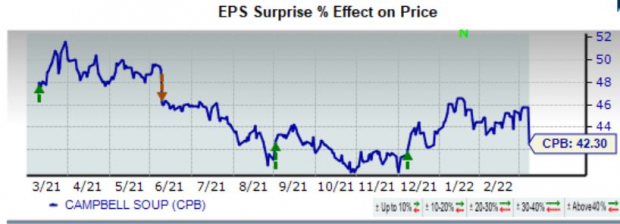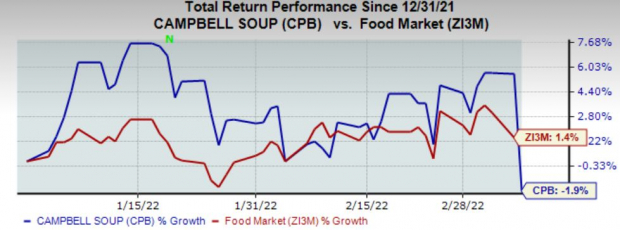Is Campbell Soup (CPB) Waving Red Flags For Investors?
Campbell Soup (CPB) reaches every corner of the world and is known for creating a range of high-quality soups and simple meals, beverages, snacks, and packaged fresh foods. CPB’s portfolio extends much farther beyond soup to foods such as the widely popular Pepperidge Farm cookies and Goldfish crackers.
CPB is slated to release its Q2 earnings report before the market opens tomorrow on March 9th.
Year-to-date, the food supplier has seen nearly a 2% decrease in valuation, a much better performance compared to the general market. However, estimates for the food supplier have declined, and margins are forecasted to diminish, shining a dim light surrounding future growth.
Key Factors Affecting Performance
The company currently resides within the Food-Miscellaneous industry, which is presently ranked in the bottom 18% of all Zacks industries. It is also worth mentioning that CPB has lagged behind the industry in general within the last five years.
The first warning sign to me is its Zacks Industry Rank. Typically, studies show that 50% of a stock’s price action can be attributed to its industry, and CPB being in an industry ranking in the bottom 18% sets off red flags. The fact that CPB has been lagging in this industry also does not bode well for me, as it seems to be a poor performer in an already poorly performing industry.
A glaring issue that CPB has been the victim of is inflation and rising labor costs within the economy. Inflation and wage increases are expected to have severe impacts on the company’s margins and have already affected Q1 of FY22. I expect margins will continue to diminish for future reports until more measures to counter inflation are enacted.
Earnings Analysis
Over the last four quarters, CPB has reported a positive EPS surprise three times, with an average surprise of 3.6%. In their latest earnings report, Campbell Soup posted a strong EPS beat of roughly 9.9%, or $0.08 per share, raising quarterly EPS to $0.89 per share.
CPB has reacted positively in each of the three previous earnings surprises, however, its share price declined 3.40% in the June 2021 earnings miss. As of now, there is reason to believe that a negative EPS surprise would affect valuation negatively.

Image Source: Zacks Investment Research
To the dislike of investors, sales have missed estimates three out of four times in the last four quarters, and sales for Q2 are expected to decline 2.6% from the prior year’s quarter. Net income is expected to decline roughly 16%, and EPS is also expected to decline by 19% compared to the prior-year quarter.
EPS is forecasted to decline from $2.98 per share in FY21 to $2.77 per share in FY22, and for FY23, EPS is expected to reach $2.90 per share. Sales for FY22 are forecasted to shrink by 1%, and net income is also forecasted to decline by a shocking 16.5%.
After analyzing the company’s recent earnings reports, it is easier to get a general sense of where CPB is currently trending. Declining sales and a shrinking bottom line are major warnings signs for future growth. Inflation and other issues are simply too strong for CPB to combat at the moment, shown by its quarterly reports.
Industry Comparison
Within a larger timeframe of five years, we can immediately see just how much CPB has lagged behind its competitors and other similar names within the industry. Since 2017, the food supplier has achieved an annualized return of -3.43%, compared to the industry’s 1.92% gain.
Smucker Jim (SJM) , a rival competitor, has managed to outpace CPB in annualized return as well, posting a return of 1.8% over the last five years. The same can be said for another competitor, Post Holdings (POST) , who has posted an annualized return of 3.2%.
Year-to-date, CPB has had a total return of -1.9% compared to the Zacks Industry's 1.4% return.

Image Source: Zacks Investment Research
A bright spot for the company is its dedication to creating shareholder value. Campbell’s 3.25% dividend yield is much higher than the industry’s yield of 2.07%. Its dividend has seen just one increase within the last five years and has a five-year annualized growth rate of 1.1%.
Campbell is expecting its bottom line to grow by 1.6% over the next three to five years compared to the industry’s forecasted EPS growth of 7.6%.
Overall, CPB is underperforming the Food-Miscellaneous industry across many key fundamentals.
Conclusion
CPB’s future is currently up in the air due to slowing growth rates, rising inflation, logistical issues, and rising labor costs. The company is ranked in an underperforming industry and is having trouble even catching up to industry averages.
Analysts have been peeling back their estimates and are forecasting revenue and net income declines overall for FY22. None of these metrics bode well coming into CPB’s Q2 report.
We will have to see what Q2 brings us, and investors should note that consensus estimates may change following tomorrow’s report. But if recent performance is any indication, investors may want to heed caution if considering Campbell’s Soup for their portfolio.
CPB has a Value Style Score of B, a Growth Style Score of C, and a Momentum Style Score of F. Its overall VGM Score is a C and is a Zacks Rank #3 (Hold).
Disclaimer: Neither Zacks Investment Research, Inc. nor its Information Providers can guarantee the accuracy, completeness, timeliness, or correct sequencing of any of the Information on the Web ...
more


